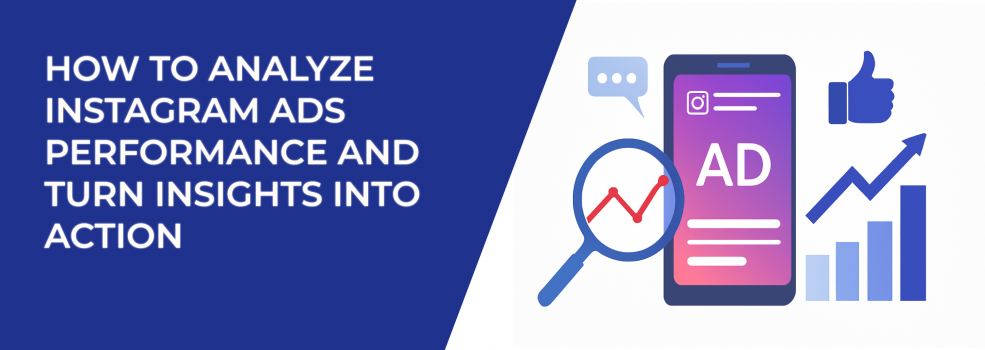Running ads on Instagram can help you reach a wide audience, but how do you know if they’re working? Simply launching a campaign isn’t enough; you need to dig into the data to understand what's going right and what’s not.
Analyzing your Instagram ad performance allows you to optimize future campaigns and drive better results. Here’s a step-by-step guide to help you break down your data and turn insights into action.
Understand the Key Metrics
When you analyze Instagram ads, it’s easy to focus on likes and comments. But these numbers don’t always tell the whole story. There are three main metrics that matter most:
-
Reach: this tells you how many unique people saw your ad. A higher reach means your ad is getting more eyes, but it doesn't always mean it's hitting the mark with your audience.
-
Engagement: engagement covers how users interact with your content — likes, comments, shares, and clicks. High engagement usually means your ad is resonating with people. But are they engaging because they like the post, or are they clicking through to learn more?
-
Conversions: ultimately, this is the goal — getting users to take the desired action, whether that’s buying a product, signing up for a newsletter, or visiting your website.
Tip: look at all three metrics together. A high reach but low engagement could mean people aren’t connecting with your ad. On the other hand, high engagement with low conversions might indicate a problem with your landing page or CTA.
High Reach here indicates good visibility, but with moderate Engagement (65%) and Conversions (50%), there’s room to improve how well your audience interacts and takes action on your ads.
Let’s say you ran an ad for a new clothing line. The reach is impressive, but the engagement and conversions are low. This could mean the ad copy or visuals aren’t compelling enough, or maybe the audience you’re targeting isn’t the right fit. Alternatively, if conversions are good but reach is limited, you might want to experiment with targeting a wider audience to bring in more sales.
Use Instagram’s Built-In Tools
Instagram offers several tools to help you analyze your ad performance. If you’re running ads through Facebook Ads Manager, you get a detailed view of how your campaigns are performing across both platforms. But Instagram also has its own tool — Instagram Insights — which can provide valuable data on how individual posts are performing.
With Instagram Insights, you can track reach, profile visits, interactions, and website clicks. This data can help you identify what’s working and where you might need to adjust your approach.
Tip: If your goal is to drive website traffic and Instagram Insights shows that clicks are low, consider refining your CTA or adjusting your audience targeting to get more relevant traffic.
These tools are helpful, but don’t stop there. You can combine Instagram Insights with data from Facebook Ads Manager for a fuller view of your ad performance.
Segment Your Audience for Better Insights
It’s tempting to look at overall campaign metrics, but this can give you a limited view. To really understand how your ads are performing, you need to break down the data by audience segment. Different groups will respond to your ads in different ways, and targeting these groups with the right message can improve your results.
Different age and gender groups can engage with and convert from ads at different rates. That's why it's important to track these differences and adjust your campaigns based on them.
For example:
-
Younger users may engage with your content, but they might not be as likely to convert.
-
Older users might not engage as much, but they could be more likely to make a purchase once they click through.
Segmenting your audience gives you the chance to tailor your messaging for each group, improving both engagement and conversions.
Tip: Test different ad variations for different segments. For example, you could create a more energetic, visually appealing ad for a younger audience and a more detailed, informative ad for an older group.
Adjust Your Creatives Based on Performance
Your ad’s visuals, copy, and call-to-action (CTA) all play a role in how well it performs. If something isn’t working, changing one of these elements can make a big difference.
Start by reviewing which types of content have performed best in your previous campaigns. Are videos getting more engagement than static images? Are carousel ads bringing in more clicks?
-
Tip: if videos are getting more engagement, create more video content for future campaigns.
-
Tip: if your CTA isn’t driving conversions, try changing it to something more compelling. Test phrases like “Shop Now” versus “Limited Time Offer!” or focus on highlighting a key benefit of your product.
Instagram is a constantly evolving platform, so staying updated on current trends is important. What worked last month might not be as effective today. Keep your content fresh and experiment with new creative ideas.
If you notice that your image ads aren’t getting the results you want, try switching to a short video that shows your product in action. Video can often capture more attention and give your audience a better understanding of what you’re offering.
Learn from Your Competitors
Looking at your own data is essential, but you can also learn from what your competitors are doing. Understanding their approach can provide fresh ideas and help you spot gaps in the market.
You can start by browsing your competitors’ Instagram profiles and analyzing the ads they’re running. What types of content are they using? How are they positioning their products? What’s their CTA like?
The Meta Ad Library is a helpful tool for seeing the ads that businesses are running on Instagram and Facebook. It lets you take a closer look at your competitors’ campaigns and provides a great source of inspiration for your own ads.
Tip: spend some time browsing the Meta Ad Library to see how other brands in your industry are advertising. Look for trends in their creative, messaging, and targeting that you can apply to your own campaigns.
If you see that a competitor’s carousel ad is getting a lot of engagement, try running your own carousel ad that highlights your products in various real-life scenarios. The key is to learn from what’s working for others, but make sure your ad stands out with its own unique approach.
If you're interested in a more in-depth guide on how to analyze your competitors' ads across Facebook and Instagram, check out The Ultimate Guide to Analyzing Your Facebook Competitors' Ad Campaigns.
Turning Insights into Action
Analyzing your ad performance doesn’t mean much if you don’t act on what you learn. Once you have the data, it’s time to make improvements.
If you find that one ad format isn’t resonating with your audience, try switching it up. If your goal is to increase conversions but your landing page isn’t working, use the insights to improve the user experience.
Tip: A/B testing is essential. Even if you find a strategy that works, don’t assume it will always perform the same. Consumer behavior changes, so continue testing different variations of your ads, copy, and targeting.
Let’s say your CTA isn’t leading to the conversions you expect. Try testing different versions of the CTA. For example, “Shop Now” could be swapped with “Exclusive Offer” or “Get Yours Today!” to create a sense of urgency.
Conclusion
Analyzing Instagram ads performance is a key step in making your campaigns more effective. Focus on the metrics that matter — reach, engagement, and conversions. Use Instagram’s built-in tools to get insights into your audience’s behavior, and adjust your creative to align with what works. Most importantly, keep testing and refining your strategies to improve performance over time.
Remember, the data you collect should be used to drive your next steps. Take action based on what you learn, and you’ll be on your way to more successful Instagram ads.
For even better results, check out our guides on Scaling Instagram Ads While Maintaining ROI: What You Need to Know and The Secret to Retargeting Success on Instagram: Best Practices.

